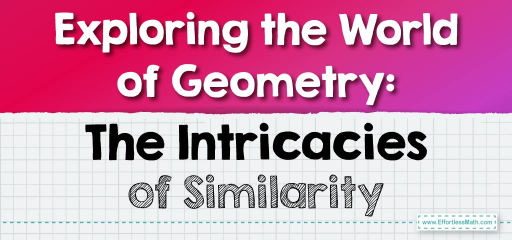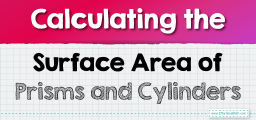Exploring the World of Geometry: The Intricacies of Similarity
In everyday language, when we say two things are similar, we generally mean they share certain qualities or characteristics. In geometry, similarity has a specific definition: two shapes are similar if they have the same shape but not necessarily the same size. This means that all their corresponding angles are congruent, and their corresponding side lengths are proportional.

Step-by-step Guide: Similarity
1. Understanding Congruence vs. Similarity:
While congruent figures are identical in size and shape, similar figures only need to have the same shape. Their sizes may differ.
2. Identifying Similar Figures:
Two polygons are similar if:
- Their corresponding angles are congruent.
- Their corresponding sides are proportional.
3. Using the Similarity Ratio:
The ratio of the lengths of the corresponding sides of similar polygons is called the similarity ratio or scale factor. Given two similar triangles \(ABC\) and \(DEF\), if side \(AB\) is twice as long as side \(DE\), the similarity ratio is \(2:1\).
Examples
Example 1:
Given two triangles \(ABC\) and \(XYZ\) with \(\angle A = \angle X = 60^\circ\), \(\angle B = \angle Y = 50^\circ\), and \(\frac{AB}{XY} = \frac{2}{1}\), are the two triangles similar?
Solution:
First, compare angles:
\(\angle A = \angle X\)
\(\angle B = \angle Y\)
Thus, the third angles, \(\angle C\) and \(\angle Z\), will also be congruent because the angles in a triangle sum up to \(180^\circ\).
Next, compare the side ratio:
Given \(\frac{AB}{XY} = \frac{2}{1}\), if the other corresponding sides of the triangles are also in the ratio \(2:1\), the triangles are similar.
Given the congruent angles and the side ratio, triangles \(ABC\) and \(XYZ\) are indeed similar.
Example 2:
Rectangles \(PQRS\) and \(MNOA\) have the same angles (since all angles in a rectangle are \(90^\circ\)). If \(\frac{PQ}{MN} = \frac{3}{2}\), are the two rectangles similar?
Solution:
All angles in a rectangle are \(90^\circ\), so \(PQRS\) and \(MNOA\) have congruent angles.
Given \(\frac{PQ}{MN} = \frac{3}{2}\), if \(\frac{RS}{OA}\) is also in the ratio \(3:2\), the rectangles are similar.
Given the congruent angles and the side ratio, rectangles \(PQRS\) and \(MNOA\) are similar.
Practice Questions:
- Two triangles \(EFG\) and \(LMN\) have sides in the ratio \(3:4\). If \(\angle E = \angle L\) and \(\angle F = \angle M\), are the two triangles similar?
- Squares \(UVWX\) and \(QRST\) have side lengths in the ratio \(5:7\). Are the two squares similar?

Answers:
- Yes, the triangles are similar.
- Yes, the squares are similar.
Related to This Article
More math articles
- Best equipment for online math teachers
- ALEKS Math FREE Sample Practice Questions
- How to Find Infinite Limits and Vertical Asymptotes?
- Top 10 Tips to Overcome TABE Math Anxiety
- Distributing Decimals: How to Multiply with a 1-digit Whole Number
- Top 10 7th Grade ACT Aspire Math Practice Questions
- Top 10 Tips to ACE the GED Math Test
- Cracking the Code: How Math is Empowering Students to Solve Real-World Problems in the Digital Age
- What is the Type of Tangents to Circles?
- Top 10 5th Grade MAP Math Practice Questions












What people say about "Exploring the World of Geometry: The Intricacies of Similarity - Effortless Math: We Help Students Learn to LOVE Mathematics"?
No one replied yet.